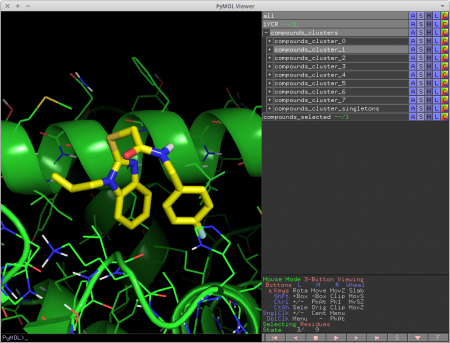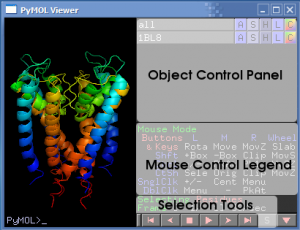The material for this series of workshops is provided as a printed workbook of 173 pages loaned during classes.

” PyMol is a multiplatform molecular graphics software with many advanced features such as rendered cartoon ribbons and surfaces, internal ray tracing and movie tools and is fast becoming the new “standard” in molecular graphics. PyMOL We have a campus-wide license agreement for PyMOL and AxPyMOL. Access to the license keys are limited to current students, faculty, and staff at Stanford.As a subscribing organization, we have access to the latest version of the software, including beta versions, as.
Create high-quality 3D images of small molecules and other biological creations. PyMol will also read x-plor maps so long as they have the extension.map. You can convert map types using the usf program mapman e.g. Re m1 mymap.map maptype (where 'maptype' is the map type - accepts OMAP PROTEIN FFT-Y TENEYCK2 CCP4 X -PLOR EZD MASK NEWEZD BINXPLOR BRICK DSN6 3DMATRIX TNT). PyMOL is a molecular visualization tool widely used by the Rosetta community. The PyMOL Wiki contains documentation on the program methods and numerous examples. Beginners should start with this tutorial.A simple workshop is part of the PyRosetta tutorials. If you are building PyMOL from source on Linux (this does not take long and is explained here) then you may need to install the python.
PyMOL workshops are currently split into 3 successive sessions.
Materials below is a slide hand-out (PDF format) and in-class set-up and summary (as live Jupyter notebook.)
At the bottom of this page, check out the video tutorials playlists from YouTube.
PyMOL Tutorial books
See also post PyMOL Tutorial Books Released (June 20, 2019)
The Biochem 660 PyMOL tutorial book has been split in 4 PDFs for easier read and download:
- Book 1: Molecular Graphics Essentials (Summary of methods to acquire 3D data; file formats)
- Book 2: PyMOL part 1 (Graphical representations and atom selection, electrostatic potentials, side-chain mutations, 3D overlays, …)
- Book 3: PyMOL part 2 (scripts, animations and movies, multimeric structures, morphing)
- Book 4: PyMOL part 3 (Electron Density Maps)
On-line hand-outs:
Added note: Parts 1-3 of the hand outs correspond altogether to books 2 and 3 above (PyMOL parts 1 and 2)
PyMOL_part 1 (of 3)
- Slides hand out part 1 (PDF, color, 6 slides per page) (last updated – September 11, 2018)
- Short hand out part 1(rendered ipython jupyter notebook)
PyMOL_part 2 (of 3)
Pymol Align

- Slides hand out part 2 (PDF, color, 6 slides per page)
- Short hand out Part 2 (rendered ipython jupyter notebook)
PyMOL_part 3 (of 3)

- Slides hand out part 3 (PDF, color, 6 slides per page)
- Short hand out Part 3 (rendered ipython jupyter notebook)
Pymol
(PYMOL sections last updated: September | October 2017)
Video Tutorials (External)
Playlist from Channel “Molecular Memory”
Playlist from “Swanson Does Science”
I want to know the position vector of some atoms in pymol. I can calculate the distances but I need the position vector instead. How can I get the atomic coordinate with respect to some define system of coordinate?
Suppose there are two atoms. How can I get the coordinates (x,y,z) of those two atoms? There must be a reference frame to calculate these coordinates with respect to it. What is that reference frame in pymol?
Pymol Educational

Я хочу знать вектор положения некоторых атомов в пимоле. Я могу рассчитать расстояния, но вместо этого мне нужен вектор положения. Как я могу получить атомную координату относительно некоторой системы координат?
Предположим, что существует два атома. Как получить координаты (x, y, z) этих двух атомов? Для расчета этих координат по отношению к нему должен быть опорный кадр. Какова эта система отсчета в пимоле?
What file format? Since a 'pdb' file largely consists of coordinates, either you are using a different file type or I don't understand your question. – John Coleman17 ноя. 152015-11-17 22:56:20
I am completely new to pymol. The file format is 'pdb'. How can I get those coordinates? Where is the origin? – MOON17 ноя. 152015-11-17 22:59:17
I haven't done much with pymol beyond using it a few times to generate cool pictures, but I did a project for a course last spring to generate protein contact maps from pdb files and found it fairly easy to write a Python function to extract the data I needed from the files. See this for a description: https://en.wikipedia.org/wiki/Protein_Data_Bank_(file_format) . On the other hand, I would be surprised if pymol didn't have some built-in parsing tools, so I would explore the help a bit more before parsing it yourself. – John Coleman17 ноя. 152015-11-17 23:06:27
If I have time I'll try to write up something tomorrow about how I extracted the data with Python. The coordinates are in angstroms and (I think) are relative to the centroid of the molecule. When I was doing this last spring I found the following quite helpful: http://www.rcsb.org/pdb/101/static101.do?p=education_discussion/Looking-at-Structures/coordinates.html – John Coleman17 ноя. 152015-11-17 23:55:53

